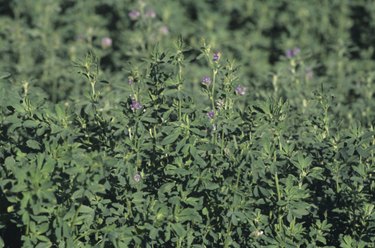
A highly nutritious food for wildlife and domesticated animals, alfalfa (Medicago sativa) is called "the premier forage legume in the United States" by the University of Kentucky. Native to Iran and the Caucasus, humans cultivated alfalfa, also called lucerne, across other parts of Asia and Europe. Settlers in the 1700s brought alfalfa to North America, where it it both grown as a field crop and has escaped cultivation to become a meadow weed. It bears tiny purple-violet flower clusters called inflorescences in late spring to early fall.
Life Cycle
Video of the Day
Alfalfa is an herbaceous perennial. Farmers sow 2- to 3-year-old seed in mid-spring and allow it to sprout, grow and establish a strong root system and lots of foliage over the first year. In milder winter areas of the southern U.S., alfalfa may also be sown 60 days before the first fall frost to grow before its first winter. Winter cold kills back the above-ground leaves and stems, but in subsequent years it regrows again in spring and then blooms. Mature, uncut plants get up to 30 inches tall and 12 to 32 inches wide.
Video of the Day
Flowering Time
When sown from seed in spring, it takes a full year before alfalfa produces its flowers. In the southern states where the growing season is long and irrigation is used in summer, spring-sown alfalfa may start to bloom by early fall. In the northern states, alfalfa planted in spring will grow and establish during the summer and die back in winter. The next spring it regrows and reliably produces its first flush of blossoms anytime from May to July, depending on location in the United States. Branching stems may continue to produce smaller flowers the rest of the summer leading up to fall frost.
Flowering Period Examples
Alfalfa is one of several forage crops raised on the American Great Plains, although it's grown across much of the Midwest, inland South and fertile valleys in the West. In Montana, the flowering season for alfalfa runs from June to August, and in the lower elevations of North Dakota, from June to September. Farther south in Wyoming and Colorado, flowering occurs from late May and June to September and October. Utah's alfalfa blooming season extends from June to August, according to the U.S. Forest Service.
Importance of Alfalfa
Farmers in the United States grow alfalfa to produce a sweet-tasting and nutritional hay for livestock, including cattle, dairy cows, goats and horses. Farmers cut the alfalfa just before the flower buds open, let it air dry and bale it. Cleared fields then regrow. When alfalfa sprouts up as roadside or meadow weeds, deer, rabbits, elk, geese and other game and water fowl use the plant for food or nesting material. Alfalfa flowers are a significant source of nectar for honeybees in North America, according to the U.S. Forest Service. As a legume, alfalfa root fix nitrogen and increase fertility of soils. Farmers till under alfalfa and then plant nutrient-hungry crops the next season.